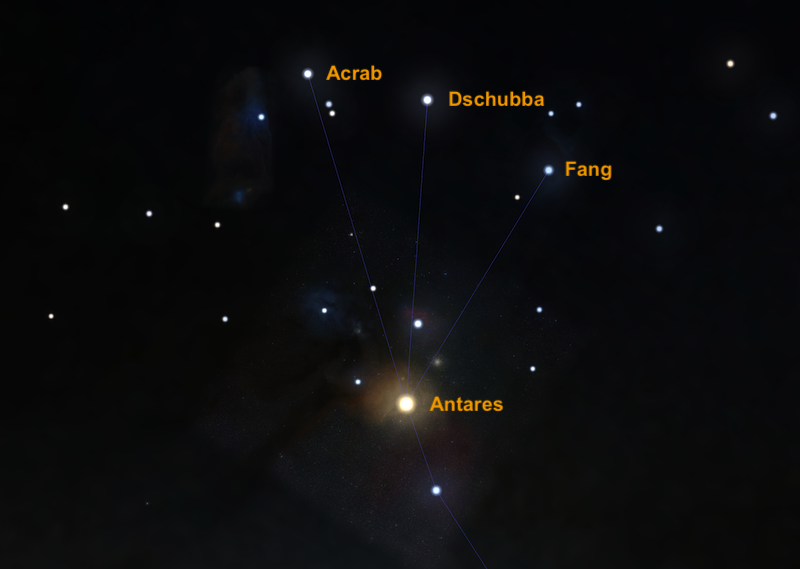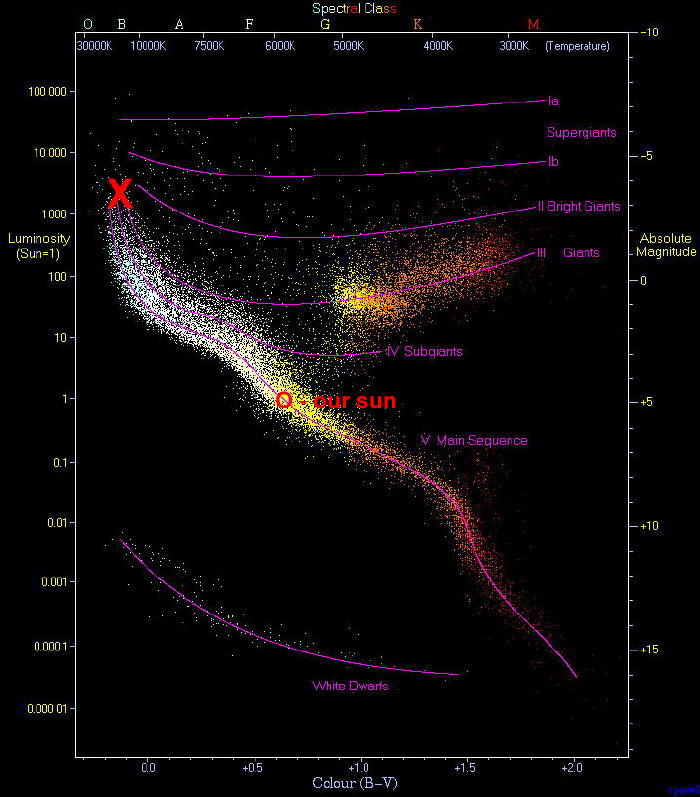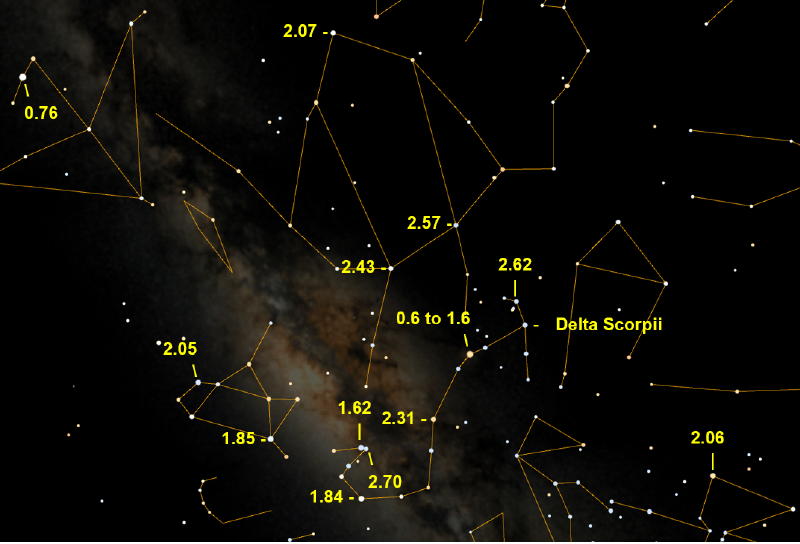Meet Delta Scorpii, aka Dschubba

Delta Scorpii – aka Dschubba – is extremely easy to spot as the middle star in the Crown of the Scorpion, Scorpius. And it’s an extremely interesting star – well worth watching – unpredictably variable now, and due to explode (maybe) some 10 to 15 million years from now!
Until it does explode, take a glance its way on these summer nights, to see if it’s still behaving. It normally shines at about magnitude 2, making it moderately bright. But it can vary in brightness. It’s noticeable as the middle star of a little arc of three stars above fiercely shining, rapidly twinkling, red Antares, the Scorpion’s Heart. These three stars are called the Scorpion Crown.
On these northern summer evenings, we in the Northern Hemisphere see Scorpius, Antares and Delta Scorpii (Dschubba) in our southern sky. For Southern Hemisphere viewers, all of these noticeable sky objects are closer to overhead.

Finding Dschubba
Use the map above to find Dschubba. First, locate Scorpius and its brightest star Antares. To the west of Antares are three stars in a north-south row, more like a column. The middle star, and usually the brightest of the three stars, is Dschubba.
How do you pronounce Dschubba? First, the “D” is silent. Maybe it was put in there to move it up in the alphabetical list of stars. So now we are left with “schubba”. It is two syllables, emphasizing the first: schub’ ba. Something like “shoe ba”.
It might be easier to simply call it “Delta Scorpii.”
Delta Scorpii derives its name from the Arabic phrase meaning “the forehead” of the scorpion. This part of the constellation is sometimes called “the claws” of the scorpion. Others see this area as the scorpion’s forehead, with the claws extending well beyond the boundaries of Scorpius and into the constellation of Libra. So far, Libra hasn’t complained. It’s a scale. What’s it going to do?

Big and bright
Dschubba is located 491 light years away, meaning the light you see tonight left the star in the year 1531. A lot has happened here on the earth since 1531. What has the starlight been doing? Some of it has been kidnapped. There is so much dust and gas between us and the star that half of the light has been reflected and absorbed in the past 491 years. So, what we see is only half as bright as it would be if we had a clear view.
Dschubba is a type B0 star, meaning it is hot. How hot? About 22,000 Kelvin, which is about four times hotter than our sun. It is a massive star too, with 13 times more mass than our sun. It is 5 times larger than our sun. And it is 14,000 times brighter than the sun. The star is marked by an “X” on the Hertzsprung Russell (HR) diagram below. An HR diagram is a two-dimensional chart plotting the stars and showing relationships between a star’s luminosity and temperatures. When many stars are plotted, they form into groups.
Maybe by now, you are thinking that our sun is puny. Well, it is not. The sun has a diameter that is 109 times larger than the earth’s. Of all the mass in the solar system, which includes planets, asteroids, and comets, the sun has 99.8% of that mass. And 1.3 million earths can fit inside the sun, where it would be very hot. “Turn on that air conditioner, honey.”

A fast rotation produces equator elongation
Dschubba has not one but two types of variability. First, it shows irregular small brightness variations. Those variations every few days are probably due to bright spots or clouds of gas between us and the star. The second type of variability is eruptive and unpredictable. That is when things get exciting.
Dschubba is a Gamma Cassiopeiae variable star. That means it behaves like the star Gamma Cassiopeiae, the poster child for a star with these eruptive brightness changes.
A few words (OK, 122 words) about Gamma Cassiopeiae. It is the middle star in the “W” we call the constellation Cassiopeia. It is an eruptive variable star whose magnitude has in the past varied between a bright magnitude 1.6 and a fainter magnitude 3.0. It spins so rapidly that it occasionally flings off material that forms a disk of gas surrounding the star near its equator. The spectrum then changes from one showing absorption lines, where the cooler gasses in the star’s atmosphere absorb the starlight, to showing emissions lines caused by the hot hydrogen gas in its surrounding disk. This type of star is classified as a “Be” star, the spectral type is “B”, and the “e” stands for and emission spectra. Be a star, or Be, a star!
It then brightens, not quickly, but slowly, taking from a few weeks to a few months. In 1937 Gamma Cassiopeiae went from magnitude 2.2 to 1.6, then dimmed to 3.4. Something like the “A” ride at your favorite amusement park. “That was fun, let’s do it again.” In the decades since the star has slowly brightened to magnitude 2.3 but has not repeated that behavior.
Only a few such stars are known to exist, one being the star Dschubba. And since Dschubba behaves like Gamma Cassiopeiae, it is known as a Gamma Cassiopeiae type variable star.
An Eruption Disruption
Dschubba rotates very quickly. At the equator it reaches the rotational speed of 112 miles per second (181 kilometers per second). This is 90 times faster than our sun. It rotates once every 45 hours. Compare that to our sun, which takes about 27 days.
This is where it gets itself into trouble. Occasionally the star throws off material that forms a disk around its equator. This is a big disk, 150 times larger than our sun. This causes changes in the brightness of Delta Scorpii.
At one time, Dschubba was a spectroscopic standard for the B0 IV star classification. But this variability in brightness got it removed from being a standard. You see, even stars misbehave and get kicked out of the class.
Dschubba is part of a multiple-star system. It has a companion that is ten times fainter, orbiting it every twenty days. Then there is another star, which may trigger the brightness outbursts. It gets as far away from the main star as our planet Saturn is from our sun, and it takes 10.8 years to orbit the main star. Every 10.8 years passes very close to Dschubba, and this may stir up the atmosphere of the main star, causing it to brighten. Or maybe not. Scientists are not sure about this; by examining the chart below, you might see the problem. The outburst that began in 2000 may have been related to the close passage of the star. Maybe not so with the passage in 2011. What will this most recent passage produce?

See for yourself
Enough of reading this article. You can become a citizen (unpaid, sigh) scientist tonight. Head outdoors and estimate the brightness of Delta Scorpii. There is no need to drag out the telescope, and you need not bring the binoculars. This can all be done with the unaided eye, and within minutes.
Simply compare the brightness of Delta Scorpii to the stars in the area. The non-variable stars are marked on the map below. While it might be tempting to use the star Antares in your estimations, avoid it because it also varies in brightness.
Typically, Delta Scorpii is about magnitude 2.3, but it has been known to brighten up to magnitude 1.6. Remember, the higher the number, the fainter the object. So how bright is it tonight?

A few tips. Take your time. Compare the subject star (Delta Scorpii) to each of the labeled stars on the map. Is it brighter or fainter? Keep doing that, comparing the subject star to the other stars on the map. Avoid using stars near your horizon as extinction will make them appear fainter than they actually are.
When you have arrived at a number, write it down, along with the date and time….
Read More: Meet Delta Scorpii, aka Dschubba

